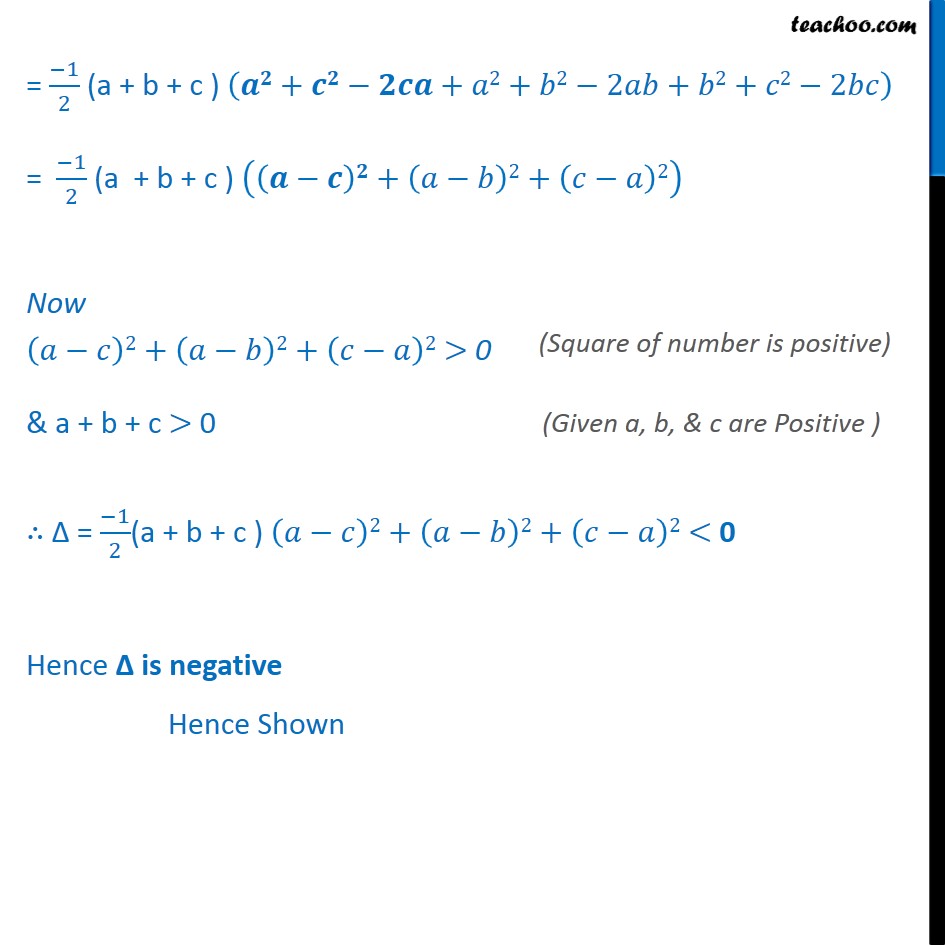



Examples
Last updated at Dec. 16, 2024 by Teachoo




Transcript
Question 12 If a, b, c are positive and unequal, show that value of the determinant Δ = abcbcacab is negative Δ = abcbcacab Applying C1→ C1 + C2 + C3 = 𝐚+𝐛+𝐜bc𝐚+𝐛+𝐜ca𝐚+𝐛+𝐜ab Taking common a + b + c from C1 = (𝐚+𝐛+𝐜) 1bc1ca1ab Applying R2 → R2 – R1 = (a+b+c) 1bc𝟏−𝟏c−ba−c1ab = (a+b+c) 1bc𝟎c−ba−c1ab Applying R3 → R2 – R1 = (a+b+c) 1bc0c−ba−c𝟏−𝟏a−bb−c = (a+b+c) 1bc0c−ba−c𝟎a−bb−c Expanding determinant along C1 = (a + b + c ) 1 c−ba−cb−cb−c−0 bc𝑎−𝑏b−c+0 bcc−ba−c = (a + b + c ) 1 𝑐−𝑎 𝑏−𝑐− 𝑎−𝑏 𝑎−𝑐−0+0 = (a + b + c ) 𝑏−𝑐 − 𝑏−𝑐−(𝑎−𝑏)(𝑎−𝑐) = (a + b + c ) − 𝑏2+𝑐2−2𝑏𝑐−(𝑎2−𝑎𝑐−𝑏𝑎+𝑏𝑐) = (a + b + c ) −a2−b2 −𝑐2+𝑎𝑏+𝑏𝑐+𝑐𝑎 = – (a + b + c ) a2+b2+𝑐2−𝑎𝑏−𝑏𝑐−𝑐𝑎 Multiplying & Dividing by 2 = – 1 × 22 (a + b + c ) a2+b2+𝑐2−𝑎𝑏−𝑏𝑐−𝑐𝑎 = −12 (a + b + c ) 2a2+2b2+2𝑐2−2𝑎𝑏−2𝑏𝑐−2𝑐𝑎 = −12 (a + b + c ) 𝑎2+𝑎2+𝑏2+𝑏2+𝑐2+𝑐2−2𝑎𝑏−2𝑏𝑐−2𝑐𝑎 = −12 (a + b + c ) 𝒂𝟐+𝒄𝟐−𝟐𝒄𝒂+𝑎2+𝑏2−2𝑎𝑏+𝑏2+𝑐2−2𝑏𝑐 = −12 (a + b + c ) 𝒂−𝒄𝟐+ 𝑎−𝑏2+ 𝑐−𝑎2 Now 𝑎−𝑐2+ 𝑎−𝑏2+ 𝑐−𝑎2 > 0 & a + b + c > 0 ∴ ∆ = −12(a + b + c ) 𝑎−𝑐2+ 𝑎−𝑏2+ 𝑐−𝑎2 < 0 Hence ∆ is negative Hence Shown